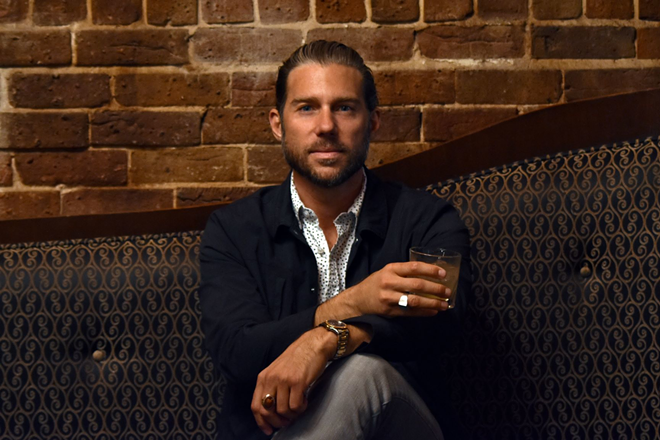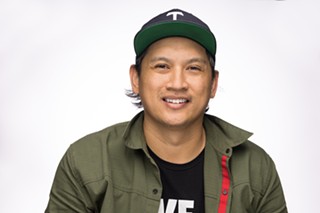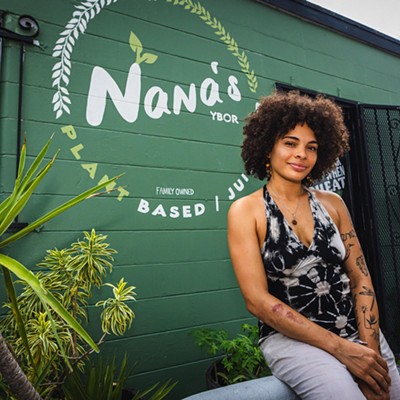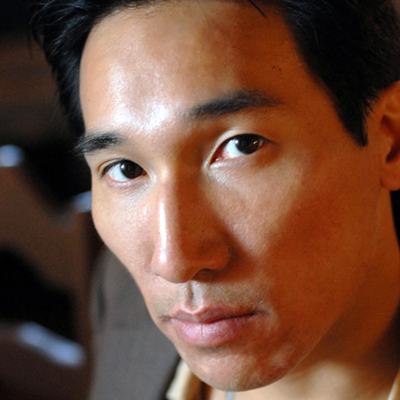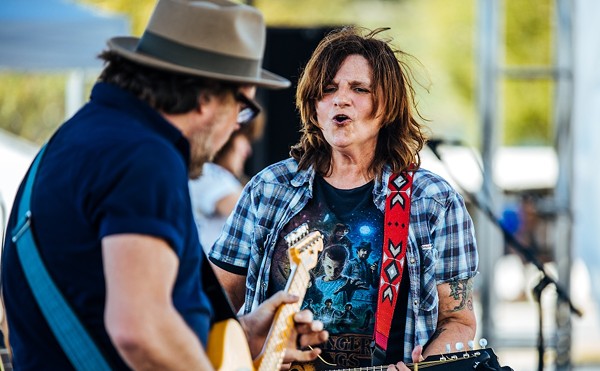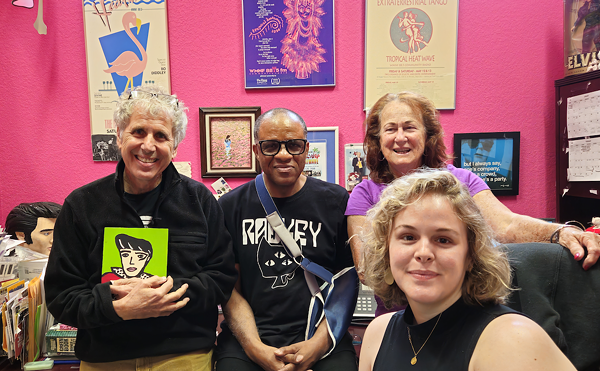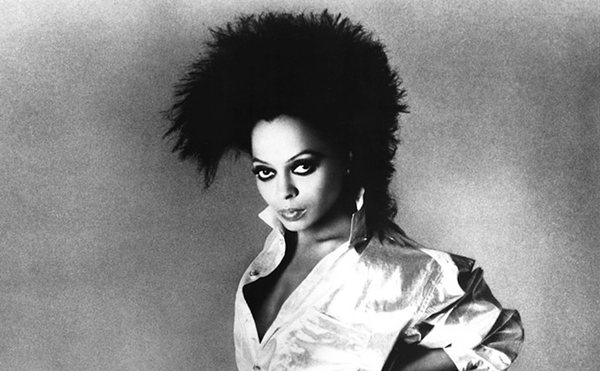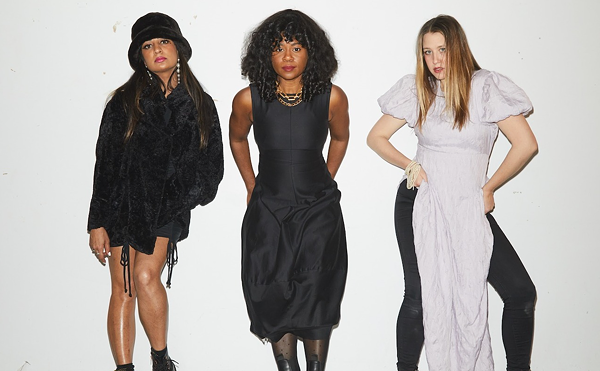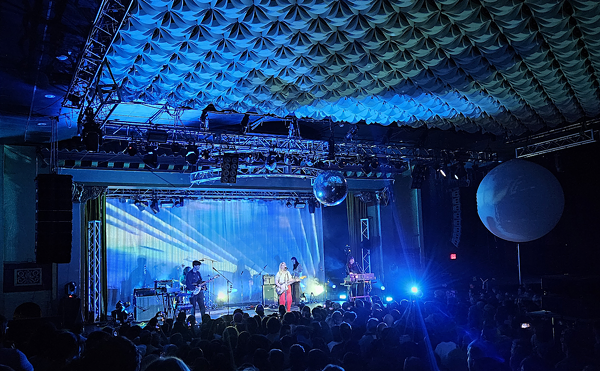In a recent interview with CL, St. Petersburg indie-pop band Polyenso detailed some of the hard work that community-minded Bay area entrepreneur and music-lover Tony Casoria put into the downtown DIY warehouse space now known as Paper Crane. Casoria, for his part, thought everyone had long forgotten about the sweat that he and Robot Studios’ Rob Durkee put into the then-abandoned venue near the I-375 interchange and Dr. Martin Luther King Jr. Street.
“We spent months knocking down walls, getting permits, building bars, and decorating this massive space to host concerts and eventually house his recording studio,” Casoria, 39, told CL.
He and his friends named the place The Attic, launched a local record label and hosted shows headlined by locals and touring bands alike. The space eventually changed hands a few times and continues to be programmed by individuals who believe that it should not go the way of other intrepid, but ill-fated, DIY spots like the Warehouse Arts District’s Venture Compound. According to Casoria, The Attic was a reaction to the music he was already booking at a pioneering downtown St. Petersburg cocktail bar he co-founded in 2010.
“At the time I was bringing touring musicians to Mandarin Hide but that was quickly outgrown and we needed a bigger space,” Casoria said. Mandarin Hide still hosts bands, but the big acts Casoria helps book now play a listening room that he and Kevin Lilly opened in early 2017. The Attic at Rock Brothers has been a welcome addition to the Ybor City music scene. Its pristine acoustics are well-suited for a seated, quiet singer-songwriter show, and staff can shift the seating to accommodate more intense drum and bass nights or a standing-room-only rock show. Beneath the venue, a wide-open, ornate tasting room pours Rock Brothers beer collaborations (Casoria and Lilly have made beers with bands like JJ Grey, Rebelution, Darius Rucker, 311 and more). Inspired cocktails that are similar to what’s being offered at Mandarin Hide are also on the menu, but the brewery’s access to certain hops, wort and beer reductions have influenced the St. Petersburg bar’s style as of late.
Niall McCourt, Director Of Spirits at Mandarin Hide, explained the philosophy behind Mandarin’s six-year-old Test Kitchen series where bartenders flex their craft cocktail muscles for customers drawn to the more experimental side of casual imbibery. Mandarin Hide — which regularly sends staff to New Orleans’ infamous Tales of the Cocktail event or on trips to the Kentucky Bourbon Trail — gives each member of the staff free reign when coming up with a Test Kitchen theme. Drinks from music-themed Test Kitchens are inspired by particular songs, lyrics or stories about the artists or band members, according to McCourt. Icons like John Lennon, Adam Ant and Jimi Hendrix have all received the Test Kitchen treatment. A Bowie Test Kitchen had the goblin king’s music playing on the PA while Labyrinth screened on the TVs. The names of cocktails, and in certain instances the color, garnish, type of spirit and ingredients chosen will be in line with the theme.
“Musicians influence so many people and that includes the creative minds of bars and bartenders,” McCourt said, adding that compositions often transport people to a significant time and place.
“That is something we try and do with every cocktail we create. By combining music and flavours together we are able to take inspiration from the works of many influential artists and continue their story.”
Casoria — who was the youngest of four siblings and consequently exposed to myriad sounds at a young age — thinks that the next chapter of his own story will include an evolution of his hospitality concepts; lately he’s been attracted to the vision of a boutique hotel where travelers can eat, sleep and drink well. He’s also unafraid to think out loud when asked about whether or not St. Petersburg can start to realize the importance preserving DIY venues like Paper Crane. Cops showed up to the first show he threw at the The Attic in St. Petersburg. Casoria spent half the night talking with police; he wasn’t sure if the powers that be would allow the venue to exist or not.
“We were dealing in some grey areas,” Casoria said. It’d be easy for municipalities in any part of the country to stop these venues, but most that do put the kibosh on the DIY scene are almost never considered progressive or truly arts-driven. Knowing that places like Venture Compound and the Warehouse Arts District’s Red Feather compound could exist gave Casoria the confidence to put more time, passion and capital into his DIY project. He was happy to pass the torch to someone when he needed to move on from the space.
“These spots become almost a rite of passage for local bands to work on their craft, get a following, and to later graduate to proper ticketed venues,” Casoria said, speaking to one of the many services underground spots provide for a scene.
In many ways, the fate of places like Paper Crane are out of Casoria’s hands. Tampa Bay’s music community has long spoken out about the importance of its small venues, but spaces like Fubar (nine years on the 600 Block) and New World Brewery (23 years in Ybor City) still had to yield to developers and their investors in recent years. In public meetings, those who might enable the preservation of DIY culture seem uninterested. Pleas to city council and the mayor’s office fall on deaf ears. Standing up for top-dollar building permits seems more sensible than standing beside the grassroots promoters and artists that’ve long tried to make the city a better place.
Maybe we’re not expressing our passion in a way that speaks to the palettes of the powerful. Perhaps we’ve simply used the wrong garnish. Or it could be that we’re pouring the wrong spirit altogether. Either way, Casoria’s experience might provide some insight. Maybe we need to sit down at the bar together and share a drink. Let’s find out how the city can fuse its preferred flavors with the tastes of underground promoters and new bands who are undoubtedly essential to making Tampa Bay a creative place worth living in. That’s worth at least a test, right? After all, a constituency should be able to tap an elected official’s shoulder, look into their eyes and ask, “Is this thing on?”
Mandarin Hide Test Kitchen. Tuesdays. 4:30 p.m. 231 Central Ave., St. Petersburg. mandarinhide.com. Read our full Q&A below.
Mandarin Hide is going on its ninth year, and a lot has changed in St. Pete and the cocktail world in that time frame. How do you think the Mandarin Hide’s role in the neighborhood has changed, and how is the staff/cocktail program continuing to be progressive in the approach to what people drink?
In 2010 when we opened there were zero craft cocktail bars in Tampa Bay. Mandarin Hide and Ciros were the first. The extent of a mixed drink for the masses ended at vodka sodas and rum and cokes. So initially we were simply re-introducing people to classic cocktails and cocktail culture. Nowadays, with most people up to speed and other true cocktail bars around, we strive to be more inventive and introduce new ways to experience a cocktail. The test kitchen is a good example of that approach.
It’s been two years of Rock Brothers, by the way. What have you learned about the Ybor City bar business in that time, and how has your clientele and staff there shaped your approach to cocktails at Mandarin Hide, if at all?
Ybor has a very close knit and loyal service industry. A lot of our staff at Rock Brothers Brewery and the Attic have been with us from the beginning. Initially Mandarin influenced the The Tasting Room at Rock Brothers, but over the last two years the influence has sometimes inspired things the other way. At the Brewery, we have access to ingredients from the brewing process and have started new categories of cocktails using hops, wort, beer and beer reductions, etc. Some of these “beertails” have made it to mandarin, along with a Mandarin Hide beer we made in the past.
Could you talk about the decision/investment that Mandarin Hide management makes to send staff to train in New Orleans (where do they go?) or go on the Kentucky Bourbon trail? How hard is it to get a job at Mandarin Hide?
We’ve been sending staff to Tales of the Cocktail in New Orleans since the early years, and have sent many on the bourbon trail. One year we brought our entire staff to NOLA for Tails, but most years we send whomever has the time and interest. We encourage it and are happy to make the investment. We don't have much turn around at Mandarin, in fact we have a bartender that has been with us since day one! Because of the lack of turnover and our high expectations on knowledge, technique and service, we tend to be pretty selective.
Let’s talk test kitchen; by my count, the events started last summer, and the Tom Hanks one was the first one built around a personality. Since then you’ve devoted TKs to musicians like Adam Ant, John Lennon, Hendrix and Bowie — how was the test kitchen born, and who makes the decisions on who gets honored with one?
Our Test Kitchen actually started in 2013, so going on six years. They have a following, but recently we’ve noticed people really taking a liking to them. After being open for a couple of years, once the public began to really pick-up on this cocktail thing we were pushing, we thought it would be cool to take a week day when it was slow where our bartenders could experiment with their craft while getting our customers involved in the process. By then every bar was claiming to be a cocktail bar so Test Kitchen was also a way to flex our craft muscles.
Each bartender is responsible for a different TK on a rotating basis, other then that they each have free reign to choose the theme for that week.The musicians that are chosen are mostly iconic, and would have a birthday or day that is unique to them that falls on or close the TK day, or if a particular artist is touring with a show nearby.
Is there a philosophy behind creating the cocktails at the TKs? Like, how is the Bowie TK different from the one for Lennon, etc.?
I asked Niall Mccourt (Director of Spirits) to answer this question, “The cocktails are inspired by particular songs, lyrics or stories about the artists or band members. Musicians influence so many people and that includes the creative minds of bars and bartenders. Music often transports people to a significant time and place and that is something we try and do with every cocktail we create. By combining music and flavours together we are able to take inspiration from the works of many influential artists and continue their story.”
We create playlists and visual entertainment for each theme. For David Bowie we had his music playing while the Labyrinth was playing on the Tv. For John Lennon we had his music playing and Documentaries about the Beatles on the TVs. The names of the cocktails, and in certain instances the color, garnish, type of spirit and ingredients chosen will be in line with the theme.
When I was interviewing Polyenso, they talked about all the work that you put into the building that is now Paper Crane.
Funny you asked, I thought that was long forgotten. In 2013 I got together with a friend (Rob Durkee/owned Robot Studios 600 block) who had just gotten access to this abandoned warehouse and together we spent months knocking down walls, getting permits, building bars, and decorating this massive space to host concerts and eventually house his recording studio. We named the place “The Attic” after our small local record label at the time called “Attic Records”. We threw some legendary underground concerts with local and touring bands.Once Rock Brothers came to be and we found our location in Ybor, “The Attic” that was the warehouse found a new home above the brewery, and “The Attic” that was the warehouse was handed down to whomever in the scene that had a vision to the space and the willingness to keep the torch lit.
After a few quick turnovers Polyenso took the reigns and made it “Paper Crane”. J.T.Brown is the captain of that ship now and he is keeping the dream alive for the time being. The same thing happened with the “Movement Sanctuary” which is also under the same roof. During the Attic Years we brought over James Oleson and he created “Bloom Collective” that eventually became MS. I feel like as long as the building owner allows it, this spot may continue to be a music, art, culture haven for years to come.
Could you talk about the motivation to do what you could with the place while you were there?
My motivation at the time was to build the brands I was developing in the music space (“The Attic,” “Attic Records,” and “Whigfest”) and to have a venue where I could do bigger shows. At the time I was bringing touring musicians to Mandarin Hide but that was quickly outgrown and we needed a bigger space.
You get to kind of exist on two spectrums of the St. Pete scene — you rub elbows with the well-heeled, but you’re also in there with venues like Paper Crane and the more underground scene. Do you think there’s a way that the city can still preserve underground/DIY venues and support the artist class while also continuing its rapid development? If so, how?
I do and it's because the city sees a value in the culture that the underground scenes add to the fabric of the city . I remember at the first show we had at The Attic (old Paper Crane) the police came and I spent half the night speaking with them and helping them understand what we were and what we were doing. I’m also an attorney so was able to speak to them from a legal perspective. At the time I wasn't sure if they would allow us to exist or not. We were dealing in some grey areas and it would be easy for the city and/or law enforcement to put an end to what we were doing. But they allowed us to exist, they allow the same thing in the warehouse arts district, and these spots become in essence a level of precedent. Think Venture Compound or the old Red Feather Compound. Knowing that those places existed gave me confidence in putting the time, passion, money into my DIY underground spot.
Another example of this is “The Loft” which was inspired by Jon Berg one night at the Attic. These spots become almost a right of passage for local bands to work on their craft, get a following, to later graduate to proper ticketed venues. You could see how it would be easy for a city to put a stop to these type things, and those that do most likely are not considered progressive, cool, artsy, etc.
We haven’t talked a lot about the music that shaped your life as a kid, teenager, young adult and adult life. What acts did you like, and what drew you to them? What is turning you on musically right now?
I was the youngest of four siblings so I was exposed to a lot of music at an early age. I remember being six years old and listening to Beastie Boys Licensed to Ill with my older brother and thinking it was the coolest thing. In the sixth grade a friend lent me Pink Floyd’s The Wall which blew me away. Around the same time I discovered Jimi Hendrix which took me down the path to all ‘60s music and everything Woodstock. Being a Florida boy, Bob Marley and Jimmy Buffet were on constant repeat as well. By high school I was getting into more contemporary stuff. We listened to everything from Sublime, 311, to Biggie, 2PAC, Pearl Jam to Pennywise. Currently I find myself listening to more poetic songwriters like Kevin Morby, Fleet Foxes, Cotton Jones, Fruit Bats to name a few.
Even music lovers spend time in silence. What do the quiet alone hours look like for you, Tony? And what kinds of things do you ruminate on when you get a chance to press pause or meditate?
I like reading and getting sun in silence on my balcony. Although music for me brings a sort of silence to my mind. I usually always have something that inspires me playing in the background at home which brings my attention to the song and the moment It’s somewhat a form of meditation.
What’s 2019 and 2020 look like for you? What do you want to be staring down when 2021 rolls around?
I’ve got a few things in the works. I'd like to evolve my hospitality concepts to the next level and am working on a boutique hotel concept. I love hosting people so the idea of creating a space where a traveler can eat, sleep, and drink at is attractive to me. I'm also working on some creative projects with friends that are too premature to mention. I like to put energy into a lot of potentialities lean towards whats pulling me the most at the time.

